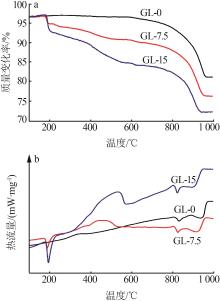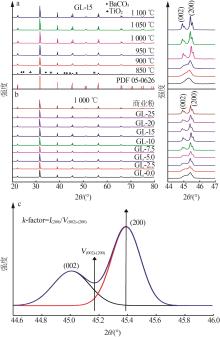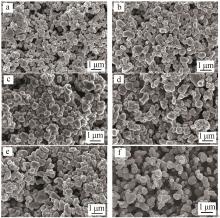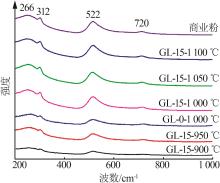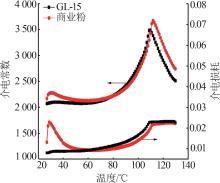| 1 |
LIU Jinpeng, YOU Xiaoqiang, CHEN Nan,et al.Fabrication of BaTiO3/epoxy composites exhibiting large dielectric constant,low dielectric loss and high flexural strength[J].Journal of Wuhan University of Technology(Mater.Sci.Ed.),2019,34(6):1266-1273.
|
| 2 |
WANG Hongxian, LIU Baibo, WANG Xiaohui.Effects of dielectric thickness on energy storage properties of surface modified BaTiO3 multilayer ceramic capacitors[J].Journal of Alloys and Compo- unds,2020,817:152804.
|
| 3 |
HUANG Yongan, LU Biao, ZOU Yixuan,et al.Grain size effect on dielectric,piezoelectric and ferroelectric property of BaTiO3 ceramics with fine grains[J].Journal of Inorganic Materials,2018,33(7):767-772.
|
| 4 |
邹清栎,邹建新.钛酸钡基电子陶瓷材料的改性进展[J].无机盐工业,2022,54(6):46-54.
|
|
ZOU Qingli, ZOU Jianxin.Modification progress on barium titanate-based electronic ceramic materials[J].Inorganic Chemicals Industry,2022,54(6):46-54.
|
| 5 |
韩淑芬,陈伟伟,于洁.钛酸钡纳米复合材料制备与性能研究[J].无机盐工业,2016,48(12):19-22.
|
|
HAN Shufen, CHEN Weiwei, YU Jie.Study on synthesis and properties of barium titanate nano-composites[J].Inorganic Chemicals Industry,2016,48(12):19-22.
|
| 6 |
TSAI H Y, CHANG S J, YANG Tingyi,et al.Distinct dispersion stability of various TiO2 nanopowders using ammonium polyacrylate as dispersant[J].Ceramics International,2018,44(5):5131-5138.
|
| 7 |
SONG E, KIM D H, JEONG E J,et al.Effects of particle size and polymorph type of TiO2 on the properties of BaTiO3 nanopowder prepared by solid-state reaction[J].Environmental Research,2021, 202:111668.
|
| 8 |
MOGHTADA A, HEIDARY MOGHADAM A, ASHIRI R.Tetragonality enhancement in BaTiO3 by mechanical activation of the starting BaCO3 and TiO2 powders:Characterization of the contribution of the mechanical activation and postmilling calcination phenomena[J].International Journal of Applied Ceramic Technology,2018,15(6):1518-1531.
|
| 9 |
ZHANG Lei, WEN Jiaxin, ZHANG Zixi,et al.Enhanced dielectric properties of BaTiO3 based on ultrafine powders by two-step calcination[J].Physica B:Condensed Matter,2019,560:155-161.
|
| 10 |
BEAUGER A, MUTIN J C, NIEPCE J C.Synthesis reaction of metatitanate BaTiO3:Part 1,Effect of the gaseous atmosphere
|
|
upon the thermal evolution of the system BaCO3-TiO2 [J].Journal of Materials Science,1983,18(10):3041-3046.
|
| 11 |
BEAUGER A, MUTIN J C, NIEPCE J C.Synthesis reaction of metatitanate BaTiO3:Part 2,Study of solid-solid reaction interfaces[J].Journal of Materials Science,1983,18(12):3543-3550.
|
| 12 |
ANDO C, TSUZUKU K, KOBAYASHI T,et al.Function of glycine during solid-state reaction toward well-crystallized fine particulate barium titanate[J].Journal of Materials Science:Materials in Electronics,2009,20(9):844-850.
|
| 13 |
OGUCHI H, ANDO C, CHAZONO H,et al.Effects of glycine on the solid-state synthesis of barium titanate micro-particles with high tetragonality[J].Journal De Physique Ⅳ(Proceedings),2005,128:33-39.
|
| 14 |
钱浩宇,朱归胜,徐华蕊,等.甘氨酸辅助微波固相合成四方相钛酸钡[J].电子元件与材料,2019,38(12):48-53.
|
|
QIAN Haoyu, ZHU Guisheng, XU Huarui,et al.Glycine-assisted microwave solid phase synthesis of tetragonal barium titanate[J].Electronic Components and Materials,2019,38(12):48-53.
|
| 15 |
ZHU Chaoqiong, ZHAO Qiancheng, CAI Ziming,et al.High reliable non-reducible ultra-fine BaTiO3-based ceramics fabricated via solid-state method[J].Journal of Alloys and Compounds,2020,829:154496.
|
| 16 |
SHERLIN VINITA V, GOWRI SHANKAR RAO R, SAMUEL J,et al.Structural,Raman and optical investigations of barium titanate nanoparticles[J].Phosphorus,Sulfur,and Silicon and the Related Elements,2022,197(3):169-175.
|
 ), HUANG Fuxiang, LONG Min, TIAN Zhongqing(
), HUANG Fuxiang, LONG Min, TIAN Zhongqing( ), MENG Fancheng, LUO Xiaoyang
), MENG Fancheng, LUO Xiaoyang
